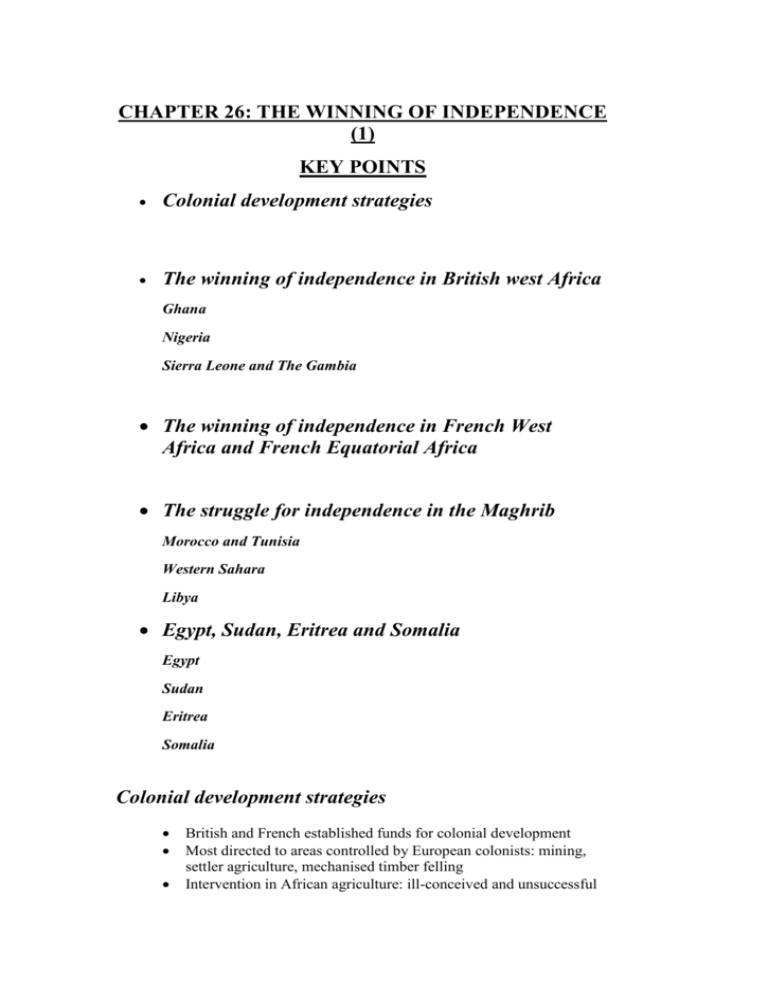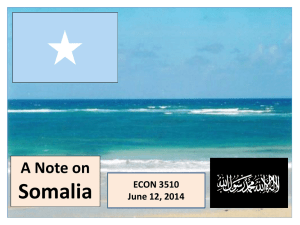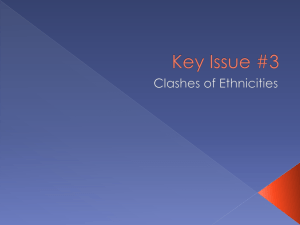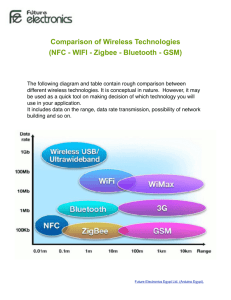Key points - Chapter 26 Chapter 26 Word Document
advertisement

CHAPTER 26: THE WINNING OF INDEPENDENCE (1) KEY POINTS Colonial development strategies The winning of independence in British west Africa Ghana Nigeria Sierra Leone and The Gambia The winning of independence in French West Africa and French Equatorial Africa The struggle for independence in the Maghrib Morocco and Tunisia Western Sahara Libya Egypt, Sudan, Eritrea and Somalia Egypt Sudan Eritrea Somalia Colonial development strategies British and French established funds for colonial development Most directed to areas controlled by European colonists: mining, settler agriculture, mechanised timber felling Intervention in African agriculture: ill-conceived and unsuccessful Sudanese Djazira cotton irrigation expanded French irrigation of cotton and rice, upper Niger (Mali) failed British groundnut scheme, Tanganyika: failed Colonial concept of Africa: exporter of raw materials, importer of manufactured goods 1950s: boom period for African commodities, disguised the shortcomings of the reliance on exports Beginning of government expenditure on health (malaria prevention); and education: mostly primary schooling – 3-4% teenagers in secondary school in 1960 New universities: Ibadan, Legon, Khartoum, Makerere French assumed higher education in France Colonial aim: gradual move towards internal self-government, within the French and British empires Rising tide of African nationalism seized the initiative from the colonial powers French and British conceded political control in belief they could retain economic power Colonies of white settlement (Algeria, Kenya, Rhodesia + South Africa [technically no longer a colony]) determined to resist all moves towards independence Portugal and Belgium had no plans for reform The winning of independence in British west Africa Ghana 1946 new Gold Coast constitution – African majority, but mostly appointed by chiefs British hoped to continue their ‘indirect rule’ through chiefs African professionals and businessmen set up United Gold Coast Convention Demanded elected not appointed representatives Nkrumah, [at Pan-African Congress of 1945], general secretary UGCC – determined to push for independence 1948, police fire on ex-servicemen’s protest at inflation – sparked riots British blamed Nkrumah and UGCC leadership – imprisoned Riots proved power of mass action: on release, Nkrumah founded Convention People’s Party (CPP) – mass membership, ‘Positive Action’ demonstrations, Nkrumah re-arrested 1951 constitution, partially elected Assembly, CPP won majority – Nkrumah released to become leader of government business in parliament Negotiations with governor for full internal self-government by 1954 – CPP won elections: Nkrumah Prime Minister Independence March 1957 CPP opposed in Asante (especially by cocoa farmers who resented continuation of marketing board and price controls) National Liberation Movement (Asante-based) to oppose CPP Nigeria 35 million population (1953) – large and disunited 1944: National Council of Nigeria and Cameroons (NCNC), Azikiwe (editor West African Pilot) – supposedly national, but main support from Igbo (south-east) Other regional parties: Yoruba Action Group and Northern People’s Congress (Hausa/Fulani) Independence delay over federal or unitary government: conservative Muslim northerners feared domination by ‘Europeanised’ southerners Federal constitution: independence 1960, northerner, Balewa, as Prime Minister Sierra Leone and The Gambia SL independence = victory of Mende elite over formerly dominant Freetown Creoles British considered possible union of The Gambia with Senegal Gambian nationalists opposed, delayed independence until 1965 The winning of independence in French West Africa and French Equatorial Africa French determined to keep colonies part of ‘Greater France’ 1946 abolition of hated indigénat and corvée labour laws Ten African delegates elected to French National Assembly (2.5% of seats – equality would have given Africans 50%) Delegates formed Rassemblement Démocratique Africain (RDA), led by Houphouet-Boigny (Côte d’Ivoire), but regional diversity prevented unity 1948 Senghor founded Bloc Démocratique Sénegalais (BDS) 1951 DBS won both Senegalese seats Dispute among delegates: federation or individual territories Senghor favoured federation – Dakar had been colonial capital of French West Africa Houphouet-Boigny feared Côte d’Ivoire’s wealth would subsidise poorer parts of FWA 1956: full internal self-government in French Africa 1958: de Gaulle’s choice: independence now, or continue links with France Guinea voted for independence – French cut them off completely Guinea supported by Ghana and Soviet Union 1960: De Gaulle agreed independence for rest of French Africa (13 countries) The struggle for independence in the Maghrib Morocco and Tunisia French ‘Protectorate’ of Morocco, ruled through Sultan Sultan Muhammad V sided with nationalist movement demanding independence French exiled Muhammad Public protest forced his return National hero, became king Muhammad V at independence 1956 Tunisia also independent 1956 (Habib Bourguiba) Western Sahara Rio d’Oro, Spanish withdrew 1976, partitioned between Mauritania and Morocco Indigenous Arab-Berbers formed Polisario Front to resist this foreign occupation of ‘Sahara Arab Democratic Republic’ (Western Sahara) Guerrilla war, aid from Algeria Mauritania withdrew 1979, Morocco continued occupation Some international recognition, but Moroccans sent in settlers to force a majority if UN ever forced a referendum Algeria France’s principal colony of white settlement – 2 million colons 1945 Muslim demonstrations fired on by police – rioting and retaliation, 100 French and 8000 Muslims killed French reforms of 1946-7 = too little too late 1954: war launched by Front de Libération Nationale (FLN), French troops in, escalation of war 1958, 500 000 French troops, bitter war, hundreds of thousands killed 1962 French forced to negotiate independence – President Ahmed Ben Bella – 1965, Ben Bella replaced by army commander, Boumedienne Libya British wartime occupation, independence 1951, King Idris (of Sanusiyya Muslim Brotherhood) 1960s huge oil reserves in desert 1969, Idris replaced in coup by Colonel Mu’ammar Gaddafi Gaddafi preached return to non-materialist Muslim values Sponsored Anti-Western tendencies Many distrusted his ambitions Egypt, Sudan, Eritrea and Somalia Egypt 1944: Egypt regained independence from British wartime occupation 1948-9: defeat in Arab-Israeli war 1952: coup, King Farouk and old Ottoman regime overthrown – blamed for defeat 1954: Colonel Gamal ’Abd al-Nasir, President of Egypt Aim: land reform – redistribute large estates among peasantry 1956 nationalised Suez Canal (French owned) Profits to finance raising Aswan Dam French and British occupy canal Forced withdrawal: Egyptian resistance, + USA and Soviet pressure Nasir nationalised all remaining French and British assets in Egypt Ended century of European domination of economy Nasir: leader of ‘Arab world’ – Egypt renamed: ‘The United Arab Republic’ Sudan North and south ruled separately for most of colonial period 1954: Egypt gave up claims to authority in Sudan Northerners dominated negotiations for independence Southern politicians demanded federation 1955: military rebellion in south Britain airlifted northern troops to south – start of first civil war (1955-72) and beginning of long-term ‘occupation’ of south by north Britain hastily negotiated independence (1 Jan. 1956) Unitary government constitution imposed by north Islamisation campaign in south to ‘enforce’ unity – civil war dominated country’s history Eritrea 1941: occupied by British British favoured strong alliance with Christian Ethiopia 1952: Muslim Eritrea handed to Ethiopia, giving them access to sea (lost since 16th century Ottoman occupation) Self-governing state within federation Ethiopia incorporated Eritrea as province within empire Muslim/Marxist liberation movements start (30-year) independence struggle from Ethiopian imperialism Somalia Somalis divided: (1) Ogaden to Ethiopia, (2) Awash estuary/port to France (Djibouti), (3) northern coast to British Somaliland, (4) central and southern to Italy, (5) south-west to Britain/Kenya Independence 1960, united (3) and (4) only Nationalists seeking ‘Greater Somalia’ Somalis divided: late-1960s election: 1000 candidates, 68 parties, for 123 parliamentary seats Coup by General Siad Barre, 1969, to resolve corruption and establish unity Aim of ‘Greater Somalia’ brought war with Ethiopia over Ogaden Barre’s ‘scientific socialism’ got Soviet support 1974: Soviets switched support to Marxist Ethiopia – 1978 Somali troops expelled from Ogaden Cold War: USA supported ‘socialist’ Somalia – US military base at Berbera Barre’s development projects favouring south Northern separatist movement: bombarded by Barre Increasingly oppressive regime – reversion to clan-based loyalties Jan. 1991: Barre fled leaving national disintegration © Kevin Shillington, 2012






